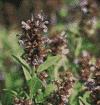- sage
-
sage1
/sayj/, n., adj., sager, sagest.n.1. a profoundly wise person; a person famed for wisdom.2. someone venerated for the possession of wisdom, judgment, and experience.adj.3. wise, judicious, or prudent: sage advice.[1250-1300; ME (n. and adj.) < OF < LL sapidus wise, tasteful (L: tasty), equiv. to sap(ere) to know, be wise, orig. to taste (see SAPIENT) + -idus -ID4]sage2/sayj/, n.2. an herb, Salvia officinalis, whose grayish-green leaves are used in medicine and for seasoning in cookery.3. the leaves themselves.4. sagebrush.[1275-1325; ME sa(u)ge < MF sau(l)ge < L salvia, deriv. of salvus SAFE (so named from its supposed healing powers)]
* * *
IIts leaves are used fresh or dried as a flavouring in many foods. The stems, 2 ft (60 cm) tall, have rough or wrinkled, downy, gray-green or whitish green oval leaves. The flowers may be purple, pink, white, or red. Since the Middle Ages, sage tea has been brewed as a spring tonic and a stimulant believed to strengthen the memory and promote wisdom. See also salvia. Sage (Salvia officinalis)Ingmar HolmasenII(as used in expressions)Sage RussellSager Ruth
Sage (Salvia officinalis)Ingmar HolmasenII(as used in expressions)Sage RussellSager Ruth* * *
▪ plantalso called Common Sage, or Garden Sage(Salvia officinalis), aromatic perennial herb of the family Lamiaceae (Labiatae) native to the Mediterranean region, cultivated for its leaves, which are used fresh or dried as a flavouring in many foods, particularly in stuffings for poultry and pork and in sausages. The bushes grow about 2 feet (60 cm) tall and have rough or wrinkled and downy, gray-green or whitish green oval leaves, and flowers are coloured according to the variety: purple, pink, white, or red. Sage has slightly stimulating properties; tea brewed from its leaves has been used as a spring tonic for centuries. In medieval Europe sage was thought to strengthen the memory and promote wisdom. The essential-oil (essential oil) content of sage varies up to about 2.5 percent; the principal components are thujone and borneol.S. officinalis, which has many varieties, grows wild and is cultivated in many parts of the world. Dalmatian sage, held in high esteem, is warmly fragrant and slightly bitter. There are several other species of Salvia (q.v.) that are also known as sage.* * *
Universalium. 2010.
